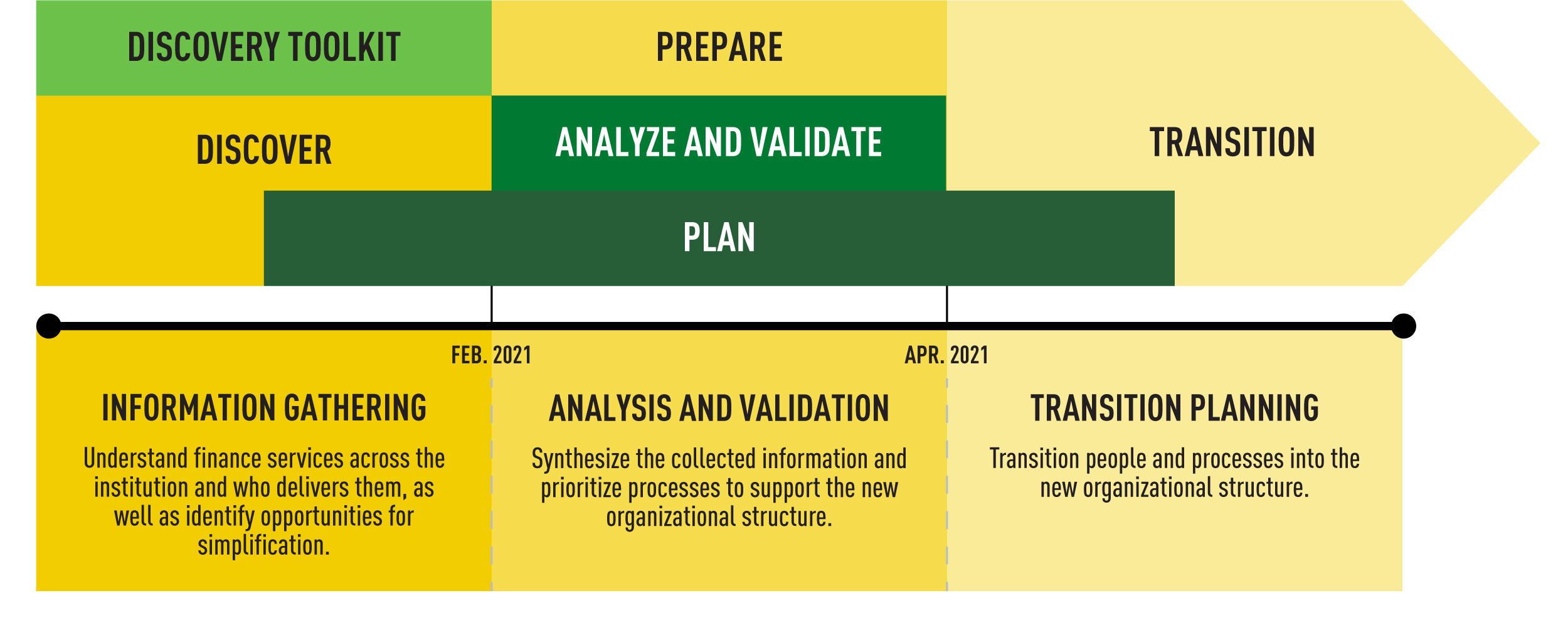Finance workstream
The finance functional review will define the people, processes, and technologies required to implement the new finance operating model across the university. Throughout administrative restructuring and transitioning, three goals remain at the centre of our efforts:
- Enhance service culture: To be a stakeholder service orientated organization by fostering collaborative partnerships and being responsive to the needs of the university.
- Improve service quality: To provide relevant stakeholders with clear data and performance measurement on the financial direction of the university in order to empower responsible decision making.
- Cost-effective service delivery: To effectively steward finances and strengthen the financial position of the university in order to maximize productivity and efficiency.
Latest updates
Service catalogue
Developed in consultation with staff from across the university, service catalogues provide a list of activities and services in a particular functional portfolio and determine where those services would be best placed within the model. For more information on the intent of the catalogues and how they were developed, please read this article.
Finance stream approach
The finance stream is divided into three phases: discover, prepare and transition. The purpose of the finance discovery is to identify what finance processes and staff activities are being done at the faculty/unit level. The process review phase will identify the processes that will be prioritized and moved forward to support the new organizational structure. The final phase will develop and implement transition plans to shift finance into the new operating model.
Process redesigns are ongoing and more information can be found on the process redesign page.

- Discover Phase (December 2020 to February 2021): Information Gathering. Understand finance services across the institution and who delivers them, as well as identify opportunities for simplification.
- Discovery Toolkit
- Begin Plan January 2021
- Prepare Phase (May 2021): Analysis and Validation. Synthesize the information collected. Identify key considerations for planning the transition (e.g. big gaps, risks, quick wins).
- Analyze and Validate
- Continue Plan
- Transition Phase (July 2021): Transition Planning. Develop and implement transition plans considering people, processes, technology, applications, and timing.
- Finish Plan end-May
Career opportunities
To view upcoming position opportunities in finance, please check the SET Position Opportunities Page (otherwise known as “POP”) regularly. Once a position has been finalized and the competition launched, you can apply to it on the U of A Careers page.
Membership
The finance stream consists of the following project team members:
- Martin Coutts — Associate VP (Finance, Procurement & Planning) — Executive Sponsor, Initiative Lead
- Brenda Hemmelgarn — Dean, Faculty of Medicine and Dentistry — Executive Sponsor
- Tobie Smith — Project Manager
- Tim Abram — Business Analyst
- Sara Horseman — Financial Analyst/Senior Finance Partner
Consultation and engagement events
- September 14, 2021: Finance Management Committee update
- July 13, 2021: Finance Management Committee project update
- June 28 & July 6: Senior Finance Partner Training and Onboarding Sessions
- June 2021: Chart of Accounts workgroups activity
- May 2021: Procurement Support workgroups activity
- April/May 2021: Payment Services workgroups activity
- April 30, 2021: Reviewed discovery priorities with Finance Management Committee
- April 30, 2021: Reviewed partner model with College Deans and College General Managers
- April 8, 2021: SET Steering Committee Presentation
- March 9, 2021: Finance Management Committee project update
- February 1, 2021: Ask SET Anything: Finance Edition
- January 22, 25, 26 & 27, 2021: Discovery workbook drop in sessions
- January 15 & 18, 2021: Discovery Workbook How-To Sessions
- January 12, 2021: Finance Management Committee Presentation
Frequently asked questions
Financial administration of research projects is an area that’s still under exploration and discussion. Overall, the PI has final responsibility for reconciliation for research projects. However, as we explore and redesign these processes, we want to ensure that support for PIs on these functions be as effective as possible.
[Updated October 25, 2021]
We want to ensure that everyone has the opportunity to apply for positions that they're qualified for, or interested in, and we’re currently working on creating more tools to be able to communicate upcoming positions.
[Updated July 27, 2021]
We have also asked all members of the SET team to complete the federal government's GBA+ training, so that we have a better understanding of unintentional biases and all EDI issues as we're designing the processes.
Was your question not asked here?
If you have questions relating to the University of Alberta for Tomorrow, Administrative or Academic restructuring, visit the U of A for Tomorrow FAQ. You can also:

